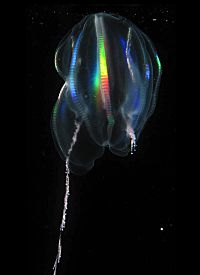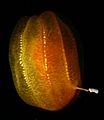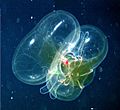Ctenophore facts for kids
Quick facts for kids Comb jellies |
|
|---|---|
 |
|
| Light refracting on comb rows of Mertensia ovum This one is damaged and asymmetrical, with right lower portion of body regenerating from damage. The body of this species is about 3 cm long. |
|
| Scientific classification | |
| Domain: | |
| Kingdom: | |
| (unranked): | |
| Phylum: |
Ctenophora
Eschscholtz, 1829
|
| Classes | |
|
Tentaculata |
|
Comb jellies, also called ctenophores (pronounced "TEE-no-fores"), are fascinating marine animals. They live in the ocean and are a type of phylum of invertebrates. This means they don't have a backbone. Many comb jellies are part of the plankton. Plankton are tiny organisms that drift in the water. Some species also live in the open ocean, far from the coast. Famous examples include the sea gooseberry (Pleurobrachia pileus) and Venus' girdle (Cestum veneris).
Even though comb jellies look a bit like jellyfish, they are not closely related. Jellyfish have stinging cells called nematocysts. Comb jellies do not have these. Instead, they have special sticky cells called colloblasts. These cells help them catch small prey. Comb jellies get their name from eight rows of tiny hairs called cilia. These cilia look like the teeth of a comb and help them swim. The word "Ctenophore" actually means "comb-bearer." These animals have simple body parts, including a nervous system. There are about 150 known species of comb jellies. They live in all parts of the world's oceans. You can find them from shallow waters to the deep sea.
Most comb jellies are soft and jelly-like. They float as part of the zooplankton. They make up a large part of the living material in the ocean. Some species, like the sea gooseberry, can become very numerous. They sometimes even clog fishing nets! Other species are very rare. It is hard to study comb jellies because they are so delicate. This means we don't know much about their lifespan. However, we do know that they start to reproduce when they are quite young.
Amazing Colours and Light
Many comb jellies that float in the ocean can create a beautiful rainbow effect. This is not because they glow from inside. It happens because of diffraction. Diffraction is when light bends and spreads out. The tiny hairs (cilia) on their comb rows cause this effect as they beat.
Most species of comb jellies can also produce their own light. This is called bioluminescence. The light is usually blue or green. You can only see it when it's dark. However, some groups of comb jellies cannot make their own light.
Images for kids
-
Light diffracting along the comb rows of a Mertensia ovum, left tentacle deployed, right tentacle retracted
See also
 In Spanish: Ctenophora para niños
In Spanish: Ctenophora para niños










